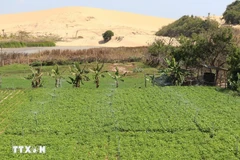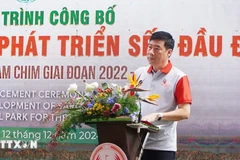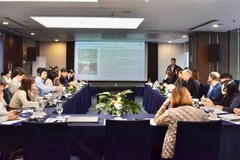Hanoi (VNA) – Vietnam has made significant progress in eliminating controlled substances that threaten the ozone layer, successfully cutting carbon emissions by 220 million tonnes, after 30 years of signatory to the Vienna Convention and Montreal Protocol, according to the Ministry of Natural Resources and Environment.
Under the national plan for managing and eliminating ozone-depleting substances and greenhouse gases, Vietnam eyes to do away with 11.2 million tonnes of CO2 equivalent which includes not just carbon dioxide but various greenhouse effect gases through the elimination of controlled substances by 2045.
Vietnam’s efforts hailed by international community
Deputy Director of the Department of Climate Change under the Ministry of Natural Resources and Environment (MoNRE) Nguyen Tuan Quang said since joining the international environmental agreements in 1994, Vietnam has carried out national programmes to do away with the harmful emissions. Immediately after joining the conventions, the country issued a national programme to gradually phase out ozone-depleting substances in 1995 and established a national programme office in 1996 to coordinate and implement the work.
With meticulous preparation, Vietnam has eliminated the consumption of 220 million tonnes of carbon through the removal of controlled substances such as chlorofluorocarbons (CFCs) and Halon chemicals used in fire extinguishers, Hydrochlorofluorocarbons (HCFCs) used in the production of cooling equipment, automotive air conditioning, and fire extinguishers, and Hydrofluorocarbon (HFC), he added.
The country has completely eliminated the consumption of CFCs and Halon substances. Methyl bromide is now strictly controlled, with imports limited exclusively to disinfection and commodity quarantine purposes. Meanwhile, HCFC substances have been managed since 2013, with a complete phase-out scheduled for January 1, 2040.
It adopted the Kigali Amendment to the Montreal Protocol in 2019, aimed at cutting HFC consumption by 80% by 2045.
Under the amendment, actions to limit the use of HFCs under the Montreal Protocol are expected to prevent the emissions of up to 105 billion tonnes of carbon dioxide equivalent of greenhouse gases. These moves will help to avoid a 0.5 degree Celsius increase in global temperatures to 2100 – a truly unparalleled contribution to climate mitigation efforts, and the single largest contribution the world has made towards keeping the global temperature rise "well below" 2 degrees Celsius, a target agreed at the Paris climate conference.
International observers have praised Vietnam's responsible and active participation in global environmental initiatives, Quang stressed. Vietnam has joined key international organisations, including the United Nations Environment Programme's Cool Coalition and Japan-led initiative on Fluorocarbons Life Cycle Management so as to reduce global emissions from cooling activities by at least 68% by 2050 as compared to 2022 level.
Most recently, the MoNRE proposed the Prime Minister issue a national plan that integrates new comprehensive management requirements to harmoniously carry out international climate and ozone protection commitments and initiatives.

As of the end of November, 285 organisations completed registration and report on the use of controlled ozone-depleting substances through the ministry’s public service portal.
11.2 million tonnes of CO2 equivalent to be cut by 2045
Looking ahead to 2045, Vietnam targets to cut 11.2 million tonnes of CO2 equivalent through eliminating controlled ozone-depleting substances.
Nguyen Dang Thu Cuc from the Climate Change Department said Vietnam has already managed the phase-out of HCFC substances and is set to begin with HFC reduction from 2024.
Accordingly, manufacturing facilities using controlled substances are required to pen rational roadmap to replace and do away with the chemicals. Meanwhile, others using products with the controlled chemicals must comply with the regulations on collection, transportation, recycling, and disposal of such substances. Notably, production, business, and service entities using controlled substances will be eligible for incentives and support during their technological conversion to ozone-layer protection technologies.
Given the multitude of environmentally-friendly cooling technologies available, Assoc. Prof. Dr. Nguyen Viet Dung, Vice Chairman of the Vietnam Society of Refrigeration and Air-Conditioning Engineers, suggested training for technical staff in refrigeration and air conditioning practices, with special focus on reducing refrigerant leakage into the environment.
He recommended building a detailed plan on cooling agent control and elimination which should adopt a life-cycle approach and promote the exchange of carbon credits in the cooling sector./.




























